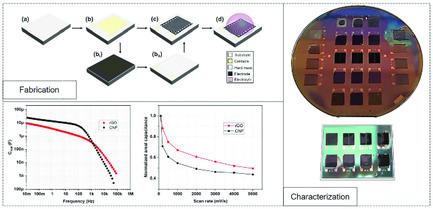当前位置:
X-MOL 学术
›
Phys. Status Solidi B
›
论文详情
Our official English website, www.x-mol.net, welcomes your
feedback! (Note: you will need to create a separate account there.)
Comparison of Thermally Grown Carbon Nanofiber‐Based and Reduced Graphene Oxide‐Based CMOS‐Compatible Microsupercapacitors
Physica Status Solidi (B) - Basic Solid State Physics ( IF 1.5 ) Pub Date : 2020-10-29 , DOI: 10.1002/pssb.202000358 Agin Vyas 1 , Simin Zare Hajibagher 1 , Qi Li 1 , Mazharul Haque 1 , Anderson Smith 1 , Per Lundgren 1 , Peter Enoksson 1
Physica Status Solidi (B) - Basic Solid State Physics ( IF 1.5 ) Pub Date : 2020-10-29 , DOI: 10.1002/pssb.202000358 Agin Vyas 1 , Simin Zare Hajibagher 1 , Qi Li 1 , Mazharul Haque 1 , Anderson Smith 1 , Per Lundgren 1 , Peter Enoksson 1
Affiliation

|
Microsupercapacitors as miniature energy storage devices require complementary metal–oxide–semiconductor (CMOS) compatible techniques for electrode deposition to be integrated in wireless sensor network sensor systems. Among several processing techniques, chemical vapor deposition (CVD) and spin coating, present in CMOS manufacturing facilities, are the two most viable processes for electrode growth and deposition, respectively. To make an argument for choosing either of these techniques to fabricate MSCs utilizable for an on‐chip power supply, we need a comparative assessment of their electrochemical performance. Herein, the evaluation of MSCs with CVD‐grown carbon nanofiber (CNF)‐based and spin‐coated reduced graphene oxide (rGO)‐based electrodes is reported. The devices are compared for their capacitance, energy and power density, charge retention, characteristic frequencies, and ease of fabrication over a large sweep of scan rates, current densities, and frequencies. The rGO‐based MSCs demonstrate 112 μF cm−2 at 100 mV s−1 and a power density of 12.8 mW cm−2. The CNF‐based MSCs show 269.7 μF cm−2 and 30.8 mW cm−2. CVD‐grown CNF outperforms spin‐coated rGO in capacitive storage at low frequencies, whereas the latter is better in terms of charge retention and high‐frequency capacitance response.
中文翻译:

热生长碳纳米纤维基和还原石墨烯基CMOS兼容的微型超级电容器的比较
微型超级电容器作为微型储能设备,需要将互补的金属氧化物半导体(CMOS)兼容技术用于电极沉积,才能将其集成到无线传感器网络传感器系统中。在几种加工技术中,存在于CMOS制造设备中的化学气相沉积(CVD)和旋涂分别是电极生长和沉积的两个最可行的工艺。为了论证选择这两种技术中的一种来制造可用于片上电源的MSC,我们需要对其电化学性能进行比较评估。本文报道了对具有CVD生长的碳纳米纤维(CNF)和旋涂还原氧化石墨烯(rGO)的电极对MSC的评估。比较了这些设备的电容,能量和功率密度,电荷保持率,特征频率以及在扫描速率,电流密度和频率的大范围扫描中易于制造。基于rGO的MSC表现出112μFcm在100 mV s -1下为-2,功率密度为12.8 mW cm -2。基于CNF的MSC显示269.7μFcm -2和30.8 mW cm -2。在低频电容存储中,CVD生长的CNF优于旋涂rGO,而后者在电荷保留和高频电容响应方面更好。
更新日期:2020-10-29
中文翻译:

热生长碳纳米纤维基和还原石墨烯基CMOS兼容的微型超级电容器的比较
微型超级电容器作为微型储能设备,需要将互补的金属氧化物半导体(CMOS)兼容技术用于电极沉积,才能将其集成到无线传感器网络传感器系统中。在几种加工技术中,存在于CMOS制造设备中的化学气相沉积(CVD)和旋涂分别是电极生长和沉积的两个最可行的工艺。为了论证选择这两种技术中的一种来制造可用于片上电源的MSC,我们需要对其电化学性能进行比较评估。本文报道了对具有CVD生长的碳纳米纤维(CNF)和旋涂还原氧化石墨烯(rGO)的电极对MSC的评估。比较了这些设备的电容,能量和功率密度,电荷保持率,特征频率以及在扫描速率,电流密度和频率的大范围扫描中易于制造。基于rGO的MSC表现出112μFcm在100 mV s -1下为-2,功率密度为12.8 mW cm -2。基于CNF的MSC显示269.7μFcm -2和30.8 mW cm -2。在低频电容存储中,CVD生长的CNF优于旋涂rGO,而后者在电荷保留和高频电容响应方面更好。











































 京公网安备 11010802027423号
京公网安备 11010802027423号